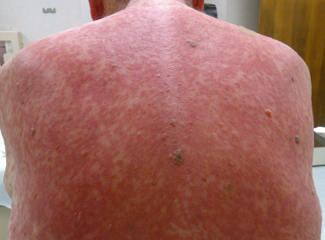Drug-Induced Hypersensitivity Syndrome Caused by Antibiotics in an Elderly Man
This is a case in which we believe vancomycin and piperacillin/tazobactam caused DIHS with lung involvement in form of bilateral pleural effusions, a very rare presentation.
A 78-year-old man with a history of hypertension, type 2 diabetes mellitus, and mantle cell lymphoma after splenectomy and chemotherapy came to the emergency department with a rash of 5 days’ duration and a 2-week history of dyspnea. He was unable to take even a few steps at the time of his presentation. He also complained of cough, with white sputum and occasional fever without chills.
The patient had started taking vancomycin and piperacillin/tazobactam (Zosyn) 3 weeks earlier during a hospitalization for osteomyelitis.

The patient had decreased breath sounds bilaterally, and a temperature of 38.3°C (101°F). Skin examination showed a maculopapular, morbiliform, palpable, nonpruritic rash that started from the trunk and involved the extremities, abdomen, and back (Figures 1, 2).
A punch biopsy from skin of the shoulder, thigh, and right flank showed perivascular and acute spongiotic dermatitis consistent with spongiotic drug eruption. Pleural fluid analysis showed exudative effusion with monocytic predominance. Peripheral blood showed atypical lymphocytosis with normal neutrophils/eosinophils.

The vancomycin and piperacillin/tazobactam regimen was discontinued, and the patient was switched to a regimen of daptomycin and moxifloxacin. Topical clotrimazole was added to prevent fungal infections.
The rash, pleural effusions, fever, and dyspnea resolved within a week after discontinuation of vancomycin/Zosyn. The patient was discharged home with prescriptions for daptomycin and moxifloxacin for treatment of his osteomyelitis.
Drug-Induced Hypersensitivity Syndrome
DIHS-also called drug rash with eosinophilia and systemic symptoms (DRESS)-a type IV drug allergy reaction, is characterized by the presence of at least 3 of the following findings1-4:
• Rash
• Fever (temperature of 38°C to 40°C)
• Eosinophilia
• Atypical circulating lymphocytes
• Lymphadenopathy
• Multiorgan failure
Very rarely DIHS can present without eosinophilia, as in our patient’s case. The liver, kidneys, heart, and/or lungs are most often affected. Anti-epileptics-including carbamazepine, phenytoin, and phenobarbital-are the agents that most commonly cause DIHS.1,2 Certain medications tend to target specific organs: anticonvulsant-induced DIHS frequently involves hepatitis; allopurinol can cause nephritis; and abacavir can cause pneumonitis.1,2
Take-home message
This is a case in which we believe vancomycin/Zosyn caused DIHS with lung involvement in form of bilateral pleural effusions, a very rare presentation. We cannot be certain which of these antibiotics caused the DIHS because both agents were started and stopped at the same time.
Corticosteroids are the usual treatment: resistant cases are treated with prolonged corticosteroid tapers.2 Recognition of vancomycin/Zosyn as a cause of DIHS is important, because many life-threatening cases have been reported.
References
1. Dauby N, Fink W, Seyler L, et al. Probable hypersensitivity reaction to vancomycin associating rash, fever and neutropenia. Acta Clin Belg. 2012;67:226-228. http://www.ncbi.nlm.nih.gov/pubmed/22897075.
2. Blumenthal KG, Patil SU, Long AA. The importance of vancomycin in drug rash with eosinophilia and systemic symptoms (DRESS) syndrome. Allergy Asthma Proc. 2012;33:165-171. http://www.ncbi.nlm.nih.gov/pubmed/22525393.
3. Fleming P, Marik PE. The DRESS syndrome: the great clinical mimicker. Pharmacotherapy. 2011;31:332.
http://www.ncbi.nlm.nih.gov/pubmed/21361742.
4. Naveen KN, Ravindra MS, Pai VV, et al. Lamotrigine induced DRESS syndrome. Indian J Pharmacol. 2012;44:798-800. http://www.ncbi.nlm.nih.gov/pubmed?term=Naveen%20KN%2C%20Ravindra%20MS%2C%20Pai%20VV.